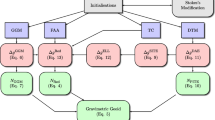Abstract
The absolute error of ellipsoidal heights that may be achieved from Real-Time Kinematic/Network Real-Time Kinematic Global Navigation Satellite Systems (RTK/NRTK GNSS) measurements varies between 3 and 5 cm. Although the vertical root mean square (RMS) error reported by receivers generally has smaller values, it can only be treated as a measure of the precision of the obtained results. Nowadays, real-time GNSS measurements are commonly used to implement surveys with increased accuracy. In some cases, it may be of concern to determine the height difference with real-time techniques than the height itself. The use of height difference may be applicable when a point with a known height is available. This offers the possibility of transferring the known height to a distant point using GNSS technology instead of geometric leveling, which is more labor-intensive. The aim of the study was to verify if achieving accuracy better than 2 cm in ellipsoidal height difference using RTK/NRTK GNSS is possible, providing special conditions of measurement. In this paper, the results of research consisting of RTK/NRTK measurement of specific points with fixed heights in various terrain conditions are presented. A single GNSS reference station was used as a base station to determine ellipsoidal height in RTK mode and Ground-Based Augmentation System (GBAS) for measurements in NRTK mode. Comparison of the ellipsoidal height difference to the results of precise leveling allows us to determine ellipsoidal height measurement errors. The measurements were carried out in open terrain, with the covered horizon (under trees) and in urbanized areas (high buildings). The method proposed by the authors in this paper does not require knowledge of the quasi-geoid model, neither normal correction to obtain measurement results.




Similar content being viewed by others
References
Alkan RM, Llci V, Ozulu IM, Halis Saka M (2015) A comparative study for accuracy assessment of PPP technique using GPS and GLONASS in urban areas. Meas 69:1–8. https://doi.org/10.1016/j.measurement.2015.03.012
Angrisano A, Gaglione S, Gioia C (2013) Performance assessment of GPS/GLONASS single point positioning in an urban environment. Acta Geod Geoph 48(2):149–161. https://doi.org/10.1007/s40328-012-0010-4
Dawidowicz K (2013) Analysis of height determination using the ASG-EUPOS NAWGEO service. Tech Sci Univ Warmia Mazury Olsztyn 16(1):19–39
Edwards SJ, Clarke PJ, Penna NT, Goebell S (2010) An examination of network RTK GPS services in Great Britain. Surv Rev 42(316):107–121. https://doi.org/10.1179/003962610X12572516251529
El-Mowafy A, Fashir H, Al Habbai A, Al Marzooqi Y, Babiker T (2006) Real-time determination of orthometric heights accurate to the centimeter level using a single GPS receiver: case study. J Surv Eng 132(1):1–6. https://doi.org/10.1061/(ASCE)0733-9453(2006)132:1(1)
Euler H-J, Keenan CR, Zebhauser BE, Wübbena G (2001) Study of a simplified approach in utilizing information from permanent reference station arrays. Proceedings of ION GPS 2001 Salt Lake City UT 3.
GUGiK web page. Publishing Government Web. http://www.gugik.gov.pl/bip/prawo/modele-danych. Accessed 1 June 2015
Gumus K, Selbesoglu MO, Celik CT (2016) Accuracy investigation of height obtained from Classical and Network RTK with ANOVA test. Measurement 90:135–143. https://doi.org/10.1016/j.measurement.2016.04.045
Hofmann-Wellenhof B, Moritz H (2005) Physical geodesy. Springer. https://doi.org/10.1007/b139113
Ince ES, Barthelmes F, Reißland S, Elger K, Förste C, Flechtner F, Schuh H (2019) ICGEM – 15 years of successful collection and distribution of global gravitational models, associated services and future plans. Earth Syst Sci Data 11:647–674. https://doi.org/10.5194/essd-11-647-2019
Janssen V, Haasdyk J (2011) Assessment of Network RTK performance using CORSnet-NSW, Proceedings of IGNSS 2011 Symposium, 15–17 November 2011, Sydney, Australia.
Kudrys J, Krzyżek R (2011) Analysis of coordinates time series obtained using the NAWGEO service of the ASG-EUPOS system. Geomatics and Environmental Engineering vol 5 no. 4 ISSN 1898–1135:39–46.
Kyungho Y, Sangkyung S, Eunsung L, Sanguk L, Jaehoon K, Ho-Jin L, Young Jae L (2009) Availability assessment of GPS augmentation system using geostationary satellite and QZSS in Seoul Urban Area. Trans Japan Soc Aeronaut Space Sci 52(177):152–158
Ögütcü S, Kalayci I (2017) Investigating precision of network based RTK techniques: baseline length is concerned. World J Res Rev (WJRR) ISSN:2455–3956 Vol. 5 Issue-1:1–3.
Pirti A, Yucel M, Gumus K (2013) Testing real time kinematic GNSS (GPS and GPS/GLONASS) methods in obstructed and unobstructed sites. Geodetski Vestnik 57(3):498–512
Regulation of Minister of Interior and Administration - in case of technical standards of performing detailed surveys and working out and sending results of these surveys to National Geodetic and Cartographic Database (in Polish) (2011) Journal of Laws 263 (entry 1572), Warsaw: Government Legislation Centre.
Retscher G (2002) Accuracy performance of virtual reference station (VRS) networks. J Global Positioning Syst 1(1):40–47
Vollath U, Buecherl A, Landau H, Pagels C, Wagner B (2000) Multi-base RTK positioning using virtual reference stations. Proceedings of ION GPS 2000 Salt Lake City UT 123–131.
Wells DE, Krakivsky EJ (1971) The method of least squares. Univ. of New Brunswick, Fredericton, Canada, lecture Notes No 18
Wolf P, Ghiliani C (1997) Adjustment computations, statistics and least squares in surveying and GIS. John Wiley & Sons, Inc. 1997
Acknowledgements
This work was carried out within the framework of statutory studies at the AGH University of Science and Technology, Faculty of Mining Surveying and Environmental Engineering, Department of Integrated Geodesy and Cartography, No. 16.16.150.545.
Author information
Authors and Affiliations
Corresponding author
Ethics declarations
Conflict of interest
The authors declare no competing interests.
Rights and permissions
About this article
Cite this article
Krzyżek, R., Kudrys, J. Accuracy of GNSS RTK/NRTK height difference measurement. Appl Geomat 14, 491–499 (2022). https://doi.org/10.1007/s12518-022-00450-2
Received:
Accepted:
Published:
Issue Date:
DOI: https://doi.org/10.1007/s12518-022-00450-2




